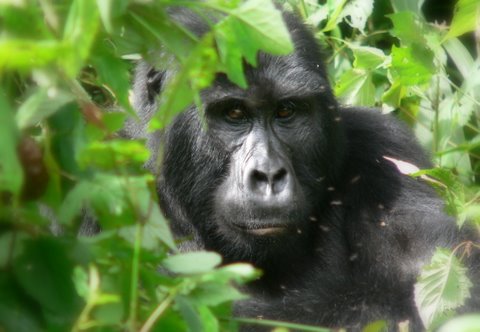|
 The
mountain gorilla (Gorilla gorilla beringei), is listed in
Appendix 1 of the Convention on International Trade in Endangered
Species of Wild Fauna and Flora and in class A of the African Convention
on the Conservation of Nature and Natural Resources as ‘vulnerable to
extinction’. Human activities such as forest clearance for agriculture
and poaching are the main threats to the mountain gorillas. Mountain
gorillas have few natural predators such as leopards. Of the 3
sub-species of gorilla, the mountain gorilla (Gorilla gorilla
beringei) is the most endangered. The
mountain gorilla (Gorilla gorilla beringei), is listed in
Appendix 1 of the Convention on International Trade in Endangered
Species of Wild Fauna and Flora and in class A of the African Convention
on the Conservation of Nature and Natural Resources as ‘vulnerable to
extinction’. Human activities such as forest clearance for agriculture
and poaching are the main threats to the mountain gorillas. Mountain
gorillas have few natural predators such as leopards. Of the 3
sub-species of gorilla, the mountain gorilla (Gorilla gorilla
beringei) is the most endangered.
A study
on the home range, group size and composition of 10 groups of mountain
gorillas in Bwindi Impenetrable National Park (BINP) was conducted for
about 14 months (November 1991 to January 1993). Five groups were
studied at lower-medium altitude (Buhoma, 1600-2000m), and 5 groups at
higher altitude (Ruhija, 2000-2500m). Each team of 2-4 park rangers
moved in a predetermined direction until a gorilla trail of less than 1
week old was found. The trails were then followed until the nest sites
were located. Mountain gorilla searches were made for at least 7
hours per day. All nest sites and trails encountered were recorded.
A total
of 5207 nests at 407 nest sites were examined. The total number of nests
encountered was less than the expected (5307)because
only adults build their own nests. Infants -and sometimes juveniles- do
not build nests. A total of 133 mountain gorillas were tracked. Group
size varied from 9-24 individuals with a mean size of 13.3. There was no
significant difference between group size of gorillas at lower and
higher altitudes. Each group was composed of at least one dominant male
(silverback) and a dominant female. Silverbacks, juveniles and adult
females accounted for 18.8%, 28.6% and 52.6% respectively. Group
composition varied from place to place. The correlation between the
group size and the number of silverbacks indicated that the larger the
group the more the silverbacks it has.
Daily
travel distance varied from 148-2036m, with an average distance of
1000metres per day. Daily distance travelled was affected by the
presence of human beings and other gorillas, with the largest distance
covered by habituated groups and those undergoing habituation.
Home
range size varied from 9-26km2. Group size affects the home
range size. Home range size of mountain gorillas at lower altitudes
was larger compared to those at higher altitudes.
The home
range sizes of the 10 Bwindi mountain gorilla groups were generally
smaller than those of mountain gorillas in Kabara (in the Democratic
Republic of Congo) and larger than those of Visoke, in the Virunga
mountains straddling the border of Congo and Rwanda. However it fell
within the mountain gorilla’s yearly range across.
|


 The
mountain gorilla (Gorilla gorilla beringei), is listed in
Appendix 1 of the Convention on International Trade in Endangered
Species of Wild Fauna and Flora and in class A of the African Convention
on the Conservation of Nature and Natural Resources as ‘vulnerable to
extinction’. Human activities such as forest clearance for agriculture
and poaching are the main threats to the mountain gorillas. Mountain
gorillas have few natural predators such as leopards. Of the 3
sub-species of gorilla, the mountain gorilla (Gorilla gorilla
beringei) is the most endangered.
The
mountain gorilla (Gorilla gorilla beringei), is listed in
Appendix 1 of the Convention on International Trade in Endangered
Species of Wild Fauna and Flora and in class A of the African Convention
on the Conservation of Nature and Natural Resources as ‘vulnerable to
extinction’. Human activities such as forest clearance for agriculture
and poaching are the main threats to the mountain gorillas. Mountain
gorillas have few natural predators such as leopards. Of the 3
sub-species of gorilla, the mountain gorilla (Gorilla gorilla
beringei) is the most endangered.